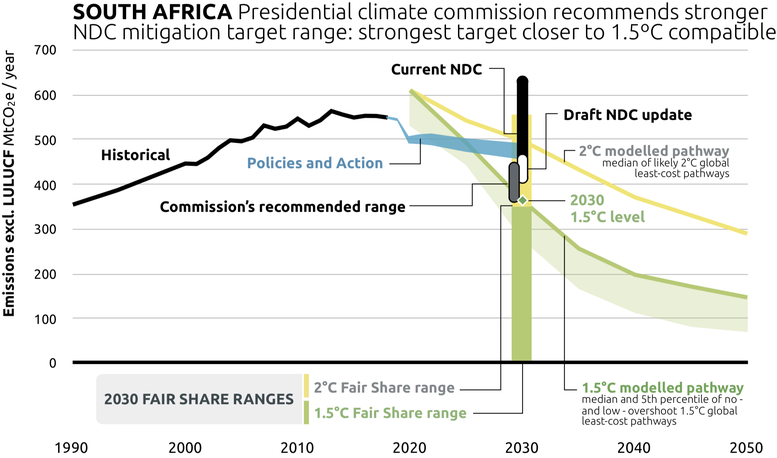South Africa's Presidential climate commission recommends stronger mitigation target range for updated NDC: close to 1.5°C compatible
Summary
The South African Presidential Climate Commission, a multi-stakeholder group established by President Ramaphosa to advise on the country’s NDC update, has recommended that South Africa put forward an even stronger target than currently contained in the government’s draft NDC. The lower end of the Commission’s proposed emission limit range is close to being 1.5°C compatible. South Africa should heed the advice of its Commission and at least adopt this lower bound as its updated NDC target. This kind of target would make South Africa one of the few countries with a 1.5°C compatible target, and turn it into a global leader against climate change. Analysis considered by the Commission shows that current policies, plus some additional no regrets measures, put this target well within reach.
CAT analysis of NDC recommendations
In March 2021, South Africa published a draft of its updated NDC, which would strengthen the country’s target range for 2030. The draft update proposed revising the 2030 NDC target from 398-614 MtCO2e to 398-440 MtCO2e (incl. LULUCF), lowering the upper bound by 28% compared to the previous NDC (see here for the CAT’s full analysis of this draft NDC).
In June 2021, the Presidential Climate Commissions (PCC) recommended that the country’s NDC be strengthened to 350-420 MtCO2e (incl. LULUCF). The lower bound is based on the adoption of no-regrets policies and is consistent with 1.5°C according to some of the analysis considered by the Commission. The upper bound is 2°C compatible according to some analysis (including from the CAT’s September 2020 assessment). The Commission noted that South Africa would need support to achieve this update target, especially the lower bound of the range.
Modelling considered by the Commission projects that under current policies South Africa’s emissions will be 371-395 MtCO2e (incl. LULUCF). In other words, the upper bound of the proposed new range could be easily met with current policies and the lower bound could be reached with the addition of further technically and economically feasible measures (with the requisite support). (The CAT has also identified a number of options to scale up climate action in South Africa). The PCC further recommends that South Africa reaffirms its commitment to reaching net-zero CO2 emissions by 2050 as presented in its Low-Emission Development Strategy.
The CAT is in the process of revising its rating system for government targets and climate action. As part of this new rating system, the CAT has derived “1.5˚C consistent modelled pathways” for each country it assesses, by downscaling global and regional 1.5°C compatible scenarios from the IPCC special report on 1.5°C, filtered to account for sustainability constraints on bioenergy use rates and magnitude of carbon dioxide removal. These scenarios distribute emission reductions across countries and sectors in a cost-effective way to limit global temperature rise to below 1.5°C by the end of the century.
A 1.5˚C-consistent target for domestic emissions reductions for South Africa would entail an absolute emissions target of 364 MtCO2e or lower excluding LULUCF by 2030. To make a fair contribution to the Paris Agreement South Africa would need to limit its emissions in 2030 to 350 MtCO2e excluding LULUCF. Excluding LULUCF, the PCC’s recommendation translates to an emissions level of 366–436 MtCO2e excluding LULUCF. The lower bound of the Commission’s recommendation is close to 1.5˚C compatible. South Africa should heed the advice of its Commission and at least adopt this lower bound as its updated NDC target, thus making it one of the few countries with a 1.5°C compatible target.
Assumptions
Global Warming Potential (GWP)
It is unclear which GWP values have been used to calculate the target range of the draft version of the updated NDC or the PCC’s recommendations. The draft NDC states that its targets are based on the latest inventory report, which uses SAR values, and that the country will transition to using AR5 in 2024.
In its first NDC, South Africa’s target range was calculated using AR4 values. As the lower bound of the target range for 2030 is 398 MtCO2e (incl. LULUCF) in both the first NDC and the 2021 draft update, we assume that South Africa has continued to use AR4 values for these figures, notwithstanding the values used in its inventory report. Likewise, as the PCC has also used these figures, we assume that its range has also been presented using AR4 values.
LULUCF
The PCC did not discuss the extent to which the land sector (LULUCF) could be used to meet the proposed NDC target. We have assumed a ten-year historical average for LULUCF emissions based on national inventory data from 2005-2015 (i.e. -16 MtCO2e), in order to be consistent with our earlier assessment of the draft NDC.
The PCC does make reference to some 1.5°C pathway modelling by the Climate Equity Reference Calculator (CERC) both including and excluding LULUCF. The difference between these two figures is -12 MtCO2e, which is comparable to our assumptions about LULUCF.
Fair share data
As part of the development of our new rating system, we have updated our equity data. The figures used here are the new data for South Africa and thus different slightly what the data shown in our main country assessment page.
Stay informed
Subscribe to our newsletter

